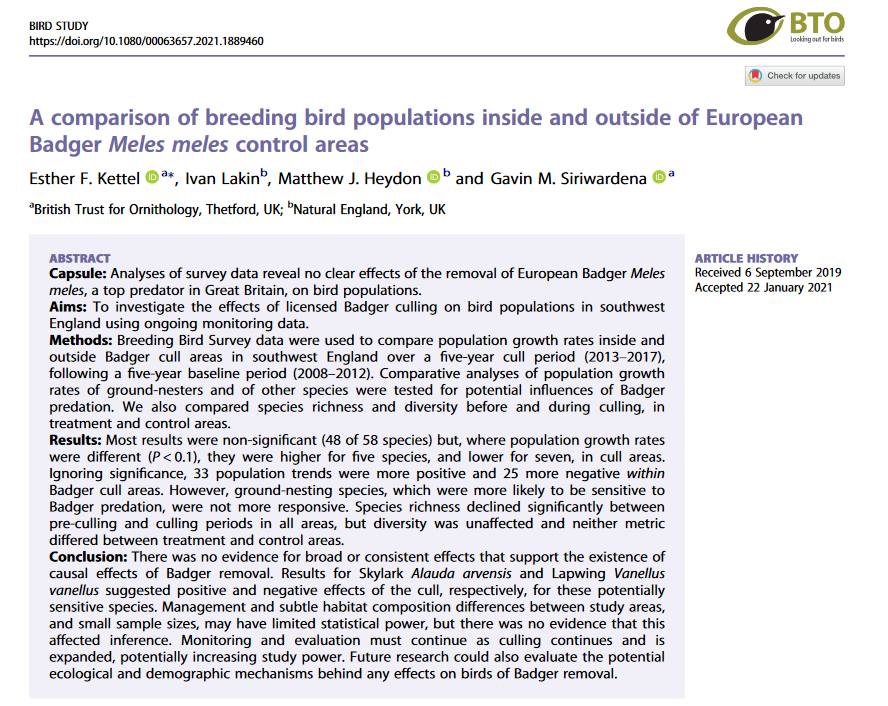This paper was published today and sometime soon it will be available free online, but at the moment the ‘free’ bit hasn’t kicked in. I have a copy of the paper sent to me by the BTO, and also by Natural England, so I’ve read it all (but don’t have access to the supplementary material online).
Badgers are predators – they are fearsome predators of earthworms but they are also partial to hoovering up any other tasty organisms into which they shamble including birds’ nests and eggs.
So, imagine the situation in which lots and lots of Badgers were killed and removed from certain areas. Would there be a plague of earthworms and might birds nest more productively? Hmmm – I wonder?
Then again, Badgers interact aggressively with Red Foxes (they have fights and compete for underground setts/dens (depending on who wins)) and gobble up Hedgehogs (they certainly do but that’s not the same as Hedgehog declines being all the fault of Badgers) and they might well interact with other predators such as Brown Rats, Stoats and Weasels. Hmmm.
How do you think those ecological intereations might pan out? If we looked at bird populations in areas where Badgers are culled would they benefit of suffer? What’s your guess?
This paper compares the fate of a bunch of bird species monitored by volunteers like me (not me in these areas) through the BTO/JNCC/RSPB Breeding Bird Survey in areas where badgers have been culled with those where they weren’t.
The overall result is that this study found no real striking differences. It did find some differences, but some went in one direction and others went in the other direction, and if we are expecting ground-nesting birds to be more affected than non-ground-nesting birds then we’ll be a bit disappointed. And the authors look at near-significant differences (P<0.1 rather than P<.05) so even some of these differences might disappear if a higher statistical hurdle were imposed (I can’t quite figure out how different the results would be because the interesting supplementary material isn’t available yet). That’s the way I read the data – see what you think.
Now it is perfectly possible to pick one species and make up a story about it. Here’s one – Lapwings get rarer where Badgers are culled (actually they got rarer everywhere during the study, but they got rarer more quickly in the cull areas (another use of the ‘R’ value – just like in coronavirus)), maybe that’s because Red Foxes are enjoying predator release in the relative absence of Badgers and the Lapwings suffer (maybe Red Foxes are better at finding Lapwing nests than are Badgers?). But, Skylarks, which nest on the ground just like Lapwings do, get commoner when Badgers are culled, so that seems to go in the opposite direction. I could make up a story for that if you gave me enough time, but it would just be a story. It’s quite difficult to see why Nuthatches should get rarer when Badgers are rarer (they do in this study) but it’s always possible to make up a story – if Badgers reduce Weasel numbers then we know that Weasels are effective predators of hole-nesting species so maybe when the Badgers disappear the Weasels run riot and the Nuthatches decline? Maybe, but Great Tits, Blue Tits and Coal Tits don’t show a similar impact.
The study had small sample sizes and therefore wasn’t very powerful but I’m not sure I would pile any more money into doing more of this on the basis of the results so far.
So does that make this study important or unimportant, and interesting or dull (all four combinations are possible) – you decide.
But what does make it interesting, to me, is that this is the published version of a ‘secret’ report produced by the BTO for Natural England in 2018. Although Natural England quoted the BTO report as being part of the evidence on which they based policy decisions on Badger culls they would not release the report to me, or to others who tried to see it. Some of those others had been directly involved in legal action against Natural England in which reference was made to the data that are also, now, the basis for this published paper. I wrote a few blogs about this – get into them through this one – click here.
As I wrote back in July, I am interested, now, to see the paper, but as I wrote back in July, I still want to see the report on which this paper is based, and i shall be asking again for a copy. Natural England’s behaviour over the report still strikes me as being highly disreputable. And the BTO, strapped for cash though it might (or might not) be, should not have agreed to secrecy over a scientific report that they produced so long after they produced it. Why doesn’t Natural England want us to see the original scientific report? That matter is still interesting and can only be cleared up by its release. So, I’ll put in another FOI request for it.
[registration_form]
The badger cull is appalling but does allow a useful study like this to be conducted. Good evidence against the simplistic arguments of those who think killing a predator will cause prey to increase.
Aldo Leopold and the wolves / deer springs to mind as a counter example – though he quickly realised the absence of wolves was not a good thing. I think he said the effect on vegetation ‘was as though someone had given God a pair of shears and forbidden him all other forms of exercise’.